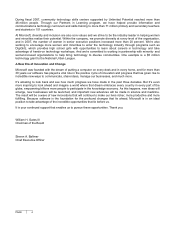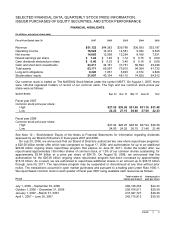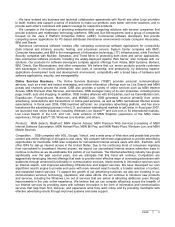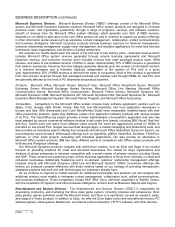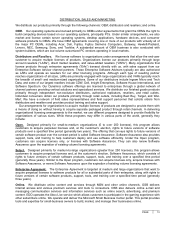Microsoft 2007 Annual Report Download - page 11
Download and view the complete annual report
Please find page 11 of the 2007 Microsoft annual report below. You can navigate through the pages in the report by either clicking on the pages listed below, or by using the keyword search tool below to find specific information within the annual report.
PAGE 10
BUSINESS DESCRIPTION (CONTINUED)
Microsoft Business Division. Microsoft Business Division (“MBD”) offerings consist of the Microsoft Office
system and Microsoft Dynamics business solutions. Microsoft Office system products are designed to increase
personal, team, and organization productivity through a range of programs, services, and software solutions.
Growth of revenue from the Microsoft Office system offerings, which generate over 90% of MBD revenue,
depends on our ability to add value to the core Office product set and to continue to expand our product offerings
in other information worker areas such as enterprise content management, collaboration, unified communications
and business intelligence. Microsoft Dynamics products provide business solutions for financial management,
customer relationship management, supply chain management, and analytics applications for small and mid-size
businesses, large organizations, and divisions of global enterprises.
We evaluate our results based upon the nature of the end user in two primary parts – business revenue which
includes Microsoft Office system revenue generated through volume licensing agreements and Microsoft
Dynamics revenue, and consumer revenue which includes revenue from retail packaged product sales, OEM
revenue, and sales of pre-installed versions of Office in Japan. Approximately 75% of MBD revenue is generated
from sales to businesses. Revenue from this category generally depends upon the number of information workers
in a licensed enterprise and is therefore relatively independent of the number of PCs sold in a given
year. Approximately 25% of MBD revenue is derived from sales to consumers. Most of this revenue is generated
from new licenses acquired through fully packaged products and licenses sold through OEMs for new PCs and
are generally affected by the level of PC shipments and product launches.
Products. Microsoft Office; Microsoft Project; Microsoft Visio; Microsoft Office SharePoint Server; Microsoft
Exchange Server; Microsoft Exchange Hosted Services; Microsoft Office Live Meeting; Microsoft Office
Communication Server; Microsoft Office Communicator; Microsoft Tellme Service, Microsoft Dynamics AX;
Microsoft Dynamics CRM; Microsoft Dynamics GP; Microsoft Dynamics NAV; Microsoft Dynamics SL; Microsoft
Dynamics Retail Management System; Microsoft Partner Program; and Microsoft Office Accounting.
Competition. Competitors to the Microsoft Office system include many software application vendors such as
Apple, Corel, Google, IBM, Novell, Oracle, Red Hat, Sun Microsystems, and local application developers in
Europe and Asia. IBM (Smartsuite) and Corel (WordPerfect Suite) have measurable installed bases with their
office productivity products. Apple may distribute certain of its application software products with various models
of its PCs. The OpenOffice.org project provides a freely downloadable cross-platform application that also has
been adapted by various commercial software vendors to sell under their brands, including IBM, Novell, Red Hat,
and Sun. Corel’s suite and many local software suites around the world are aggressively priced for OEMs to
preinstall on low-priced PCs. Google has launched Google Apps, a hosted messaging and productivity suite, and
also provides an enterprise search offering that competes with Microsoft Office SharePoint Server for Search, our
new enterprise search product. Web-based offerings such as AjaxWrite, gOffice, iNetOffice, SimDesk, ThinkFree,
wikiCalc, or other small projects competing with individual applications, can also provide an alternative to
Microsoft Office system products. IBM has many different points of competition with Office system products with
its Notes and Workplace offerings.
Our Microsoft Dynamics products compete with well-known vendors such as Intuit and Sage in the market
focused on providing solutions for small and mid-sized businesses. The market for large organizations and
divisions of global enterprises is intensely competitive with a small number of primary vendors including Oracle
and SAP. These vendors are positioning many of their business applications to focus more intensely on small and
mid-sized businesses. Additionally Salesforce.com’s on-demand customer relationship management offerings
compete directly with Microsoft Dynamics CRM Live and Microsoft Dynamic CRM’s on-premise offerings. We
believe our products compete effectively with these vendors based on our strategy of providing interoperable,
adaptable solutions that work well with technologies our customers already have.
As we continue to respond to market demand for additional functionality and products, we will compete with
additional vendors, most notably in enterprise content management, collaboration tools, unified communications,
and business intelligence. These competitors include SAP; IBM; Cisco, with their acquisition of WebEx; Oracle,
with the acquisition of Hyperion; and other business intelligence vendors such as Business Objects and Cognos.
Entertainment and Devices Division. The Entertainment and Devices Division (“EDD”) is responsible for
developing, producing, and marketing the Xbox video game system, including consoles and accessories, third-
party games, games published under the Microsoft brand, and Xbox Live operations, as well as research, sales,
and support of those products. In addition to Xbox, we offer the Zune digital music and entertainment device; PC
software games; online games; Mediaroom, our Internet protocol television (“IPTV”) software; and other devices.





